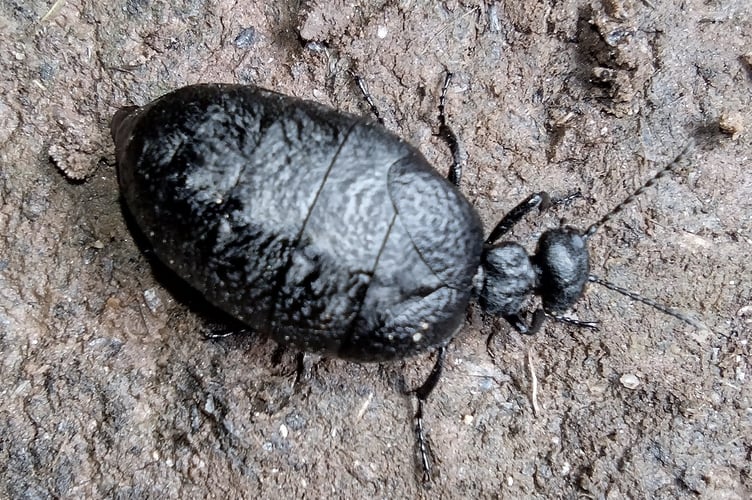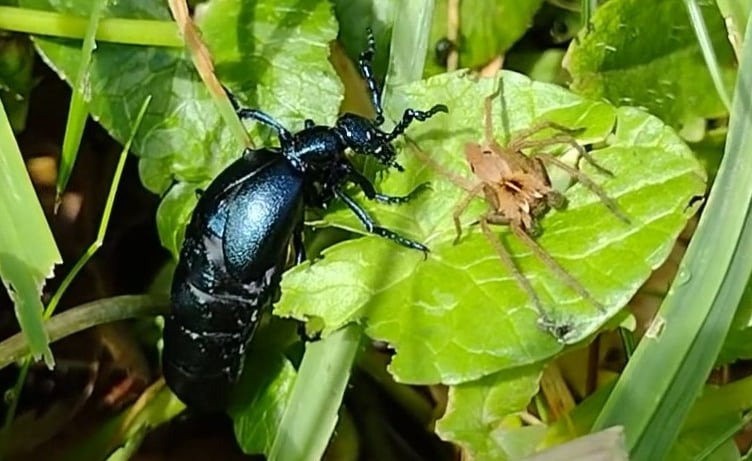I make no apology for dedicating one of my Nature Diaries to big, black beetles. They have been a source of fascination since my father first read ‘Forgiven’ to me by A.A. Milne, a delightful poem about a black beetle, discovered by a little boy, put into a match-box and named ‘Alexander’. Alas, his nanny, in her search for a match, unwittingly allows Alexander Beetle to escape but after boy and nanny go searching in all the right sort of places there is a happy ending where the little boy sees ‘a kind of something’ and gives a shout: “A beetle-house and Alexander Beetle coming out!”

If you take nothing else from this Nature Diary, please take my encouragement to read (or make up) stories and poems to share aloud with children – your own, those of friends or relatives, as a volunteer at your local primary school, wherever! Sparking love, joy and curiosity in the natural world through words and laughter is one of the most precious gifts you can give a child.
And so, to spring and the emergence of all things bright and beautiful – including some of our biggest black beetles here in the south west: oil beetles. And among the largest of these is one of our most common, the black oil beetle which grows up to a whopping 30mm long! If you have never seen one, I suggest you head out into the countryside on a sunny morning in March or April and look for a grassy bank or verge where lesser celandines are abundant: a buttercup family member with glossy, yellow petals and round, succulent leaves; then, stand still, watch and listen. After a while, you may hear a rustling. Trace the sound to its source and you could be rewarded with the sight of some blue-black antennae and legs waving as a huge black beetle pushes its way through leaf litter to find this favourite foodplant. Or, as I did yesterday, see two of these beetles, conjoined; the larger female dragging her smaller mate along backwards, presumably her desire to feed outweighing her interest in copulation.
Oil beetles are known as ‘kleptoparasites’ which simply means that they have evolved to thieve in order to survive. Eggs laid in a shallow burrow by a gravid female eventually hatch into tiny, hooky-legged larvae (looking unnervingly like head-lice) which then climb up into flower heads and await the arrival of hole-nesting bees. Clinging on, the successful 'triungulin' larvae are carried back to the furry, solitary bee's underground pollen store which they then eat, stealing from her young (hence 'klepto') until fully grown. Of the thousands of eggs laid, only a few will make it through to adult beetle-hood.

And now, if you are sitting comfortably, I am going to tell you another story about an oil beetle hunt from just a few short months ago…
It was a dark, winter's night at Start Point, just the place for a nocturnal ramble along a cliff edge. Chief Beetle Tracker was (the surely now legendary?) John Walters, highly regarded local naturalist and Thoroughly Nice Chap, accompanied by Sam and Rob from the AONB’s Life on the Edge team. We were a small, well-wrapped-up and be-torched group of both experienced and novice enthusiasts gathered in the lighthouse car park awaiting a guided search of the coast path: a hunt for the rare and elusive Mediterranean Oil Beetle.
We would have been a strange sight, had anyone been out to see us, shuffling along in a hunched-over crocodile but after some time, success! Amidst the numerous Minotaur beetles, busily rolling bits of sheep dung around; one female Mediterranean Oil Beetle. Not quite as large, shiny and charismatic as Black Oil Beetles but with an equally fascinating and precarious lifecycle, this time conducted in the dark nights of winter.

If you've read this far, you deserve the next bit of this nocturnal adventure...
John was explaining why they are known as 'oil beetles', letting us look through his illuminated hand lens at the tiny, oily droplets exuded from their knee joints, produced when disturbed as a very effective predator deterrent. Always curious, I said, "John, I have to ask this, have you ever licked an oil beetle to find out what makes it so unpalatable?" (Seriously, if you knew some of the entomologists I do, this would not be a silly question). John smiled a thoughtful smile and answered, "No."
He went on to explain that this was not a good idea as the oil contains ‘Cantharidin' which, whilst it is renowned for its Viagra-like effects, is also very likely to kill you.
SO, DO NOT LICK OIL BEETLES!!! Apparently, they are quite closely related to another beetle which you may have heard of, called 'Spanish Fly.’




